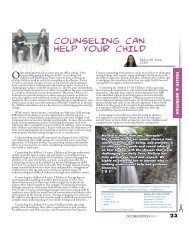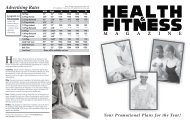How Happy Are Your Feet? - Health & Fitness Magazine online!
How Happy Are Your Feet? - Health & Fitness Magazine online!
How Happy Are Your Feet? - Health & Fitness Magazine online!
You also want an ePaper? Increase the reach of your titles
YUMPU automatically turns print PDFs into web optimized ePapers that Google loves.
It’s easy to start a new exercise program<br />
or a new diet program and impact<br />
one’s health positively. But when<br />
the improvement received from these<br />
known health boosters is less than expected,<br />
it’s time to look for other factors<br />
that may be impacting health.<br />
Over the last few decades, research<br />
scientists not only from the EPA but<br />
from major institutions worldwide<br />
have confirmed the idea that hidden<br />
dangers in the home can contribute to<br />
poor health. These dangers occur not<br />
only from not cleaning the house properly<br />
but also from problems with home<br />
construction or natural geography.<br />
Below is a list of 12 of these<br />
insidious dangers that will be<br />
addressed in this series.<br />
1. Radon<br />
2. Electromagnetic radiation (EMR)<br />
3. Asbestos<br />
4. Lead in old plumbing and on paint<br />
that is chipping<br />
5. New carpeting<br />
6. Dirty heating and air conditioning<br />
units<br />
7. Mold from water intrusion<br />
8. Inadequate bathroom ventilation<br />
9. Humidifiers with stagnant water<br />
10. Little known sources of bacteria<br />
and microbes<br />
11. Leaky dishwasher<br />
12. Dust in the home and dust mites in<br />
the bed<br />
By Dr. Donna Schwontkowski<br />
Is <strong>Your</strong> House<br />
Contributing to <strong>Your</strong> <strong>Health</strong>?<br />
uranium in rock, soil and well water. It<br />
seeps into the home through cracks and<br />
holes in the foundation. The gas passes<br />
into the air you breathe and cannot be<br />
seen, tasted or smelled. Radon is trapped<br />
inside the home.<br />
Radon is a leading cause of lung cancer<br />
among non-smokers, causing 21,000<br />
deaths per year (Source: EPA. 2003 Assessment<br />
of Risks from Radon in Homes,<br />
EPA #402-R–03-003) If you smoke and<br />
your home has high radon levels, your<br />
risk of lung cancer is especially high according<br />
to the EPA.<br />
Is Radon a Real Threat?<br />
The EPA estimates that 1 out of every<br />
15 homes in the U.S. has elevated radon<br />
levels. Testing the home is the way to<br />
discover if your home (or office) is affected.<br />
Homes, schools and office buildings<br />
should be tested and only takes a<br />
few minutes of your time.<br />
If your home’s radon level is 4 picocuries<br />
per liter (pCi/L) or higher, you’ll need<br />
to take action and protect your family<br />
from this harmful gas. Radon reduction<br />
systems are not too costly and can reduce<br />
this hidden killer by up to 99%. Every<br />
state has a governmental radon office for<br />
qualified testers and information about<br />
radon problems in schools, daycare and<br />
childcare facilities as well as workplaces<br />
in your area. In the Sacramento area, call<br />
916-449-5674. (See www.epa.gov/radon)<br />
<strong>How</strong> is Radon Testing<br />
Accomplished?<br />
Part 1<br />
HEALTH & THE ENVIRONMENT<br />
The EPA has designated January as National Radon<br />
Action Month to increase the public’s awareness of<br />
the health risks that arise from radon.<br />
Put the testing device in a room frequented<br />
often by household members<br />
excluding the kitchen or bathroom, 20<br />
inches above the floor away from drafts,<br />
heat, humidity or exterior walls. Leave<br />
the kit there undisturbed for the required<br />
time period. Then reseal the package and<br />
send it back to the lab. <strong>Your</strong> results will<br />
be ready in a few weeks.<br />
IF your water supply is the source of<br />
contamination, a whole house filtration<br />
system is the best solution. Radon is removed<br />
from water by granular activated<br />
carbon filters (GAC) or aeration systems;<br />
however, GAC filters can collect radioactivity<br />
and may be considered a toxic<br />
waste. Discuss solutions with your state<br />
radon office.<br />
Our first hidden danger addressed<br />
in this issue is Radon.<br />
The EPA has designated January as National<br />
Radon Action Month to increase<br />
the public’s awareness of the health risks<br />
that arise from radon.<br />
What is Radon and <strong>How</strong> Does It<br />
Affect Us?<br />
Radon is a natural radioactive gas emanating<br />
from the natural breakdown of<br />
Testing is quite easy. Tests can be either<br />
short-term (2 to 3 days up to 90 days)<br />
or longer. Obtain a charcoal canister,<br />
electret ion chamber, alpha track, continuous<br />
monitor or a charcoal liquid<br />
scintillation detector and test your home<br />
for 90 days.<br />
Close your windows and doors during<br />
the test. Don’t bring in outside air from<br />
fans or other devices; HVAC systems<br />
are fine and may be turned on. Also,<br />
don’t conduct the test during severe<br />
storms or high winds.<br />
My Home is High in Radon; Now<br />
What?<br />
If your home is found to be high in radon,<br />
a soil suction radon reduction system<br />
can be installed which is a vent pipe<br />
system and fan that pulls radon from<br />
beneath the house and vents it to the<br />
outside. Combined with sealing foundation<br />
cracks make this system more costefficient<br />
and more effective. The EPA<br />
recommends that you use a state-certified<br />
and/or qualified radon mitigation contractor<br />
to fix any radon problems.<br />
Resources<br />
• Order test kits from the National Safety<br />
Council/EPA by phone by calling 1-<br />
800-SOS-RADON (767-7236).<br />
• Obtain EPA radon publications from the<br />
number above or the Indoor Air Quality<br />
Information Clearinghouse at 1-800-<br />
438-4318.<br />
In our next issue, find out about how electromagnetic<br />
radiation can affect your health.<br />
January Edition 2009<br />
33









